Business Strategy Report: MILK Education Recruitment Agency
VerifiedAdded on 2023/01/18
|12
|4137
|66
Report
AI Summary
This report provides a comprehensive analysis of MILK Education, a recruitment agency, focusing on its business strategy. It begins with an introduction to business strategy, emphasizing its role in guiding organizations towards achieving predetermined goals. The report then delves into an internal analysis of MILK Education using SWOT and VRIO frameworks, evaluating its strengths, weaknesses, opportunities, and threats, as well as its resources. Subsequently, Porter's Five Forces model is applied to examine the competitive forces within the recruitment industry, assessing competitive rivalry, bargaining power of suppliers and customers, the threat of new entrants, and the threat of substitutes. Finally, the report discusses the implication of relevant theories and concepts, culminating in the development of a strategic management plan to enhance MILK Education's competitive edge and achieve its objectives. The report underscores the importance of understanding both the internal and external environments for effective strategic decision-making and sustainable business growth in a dynamic market.
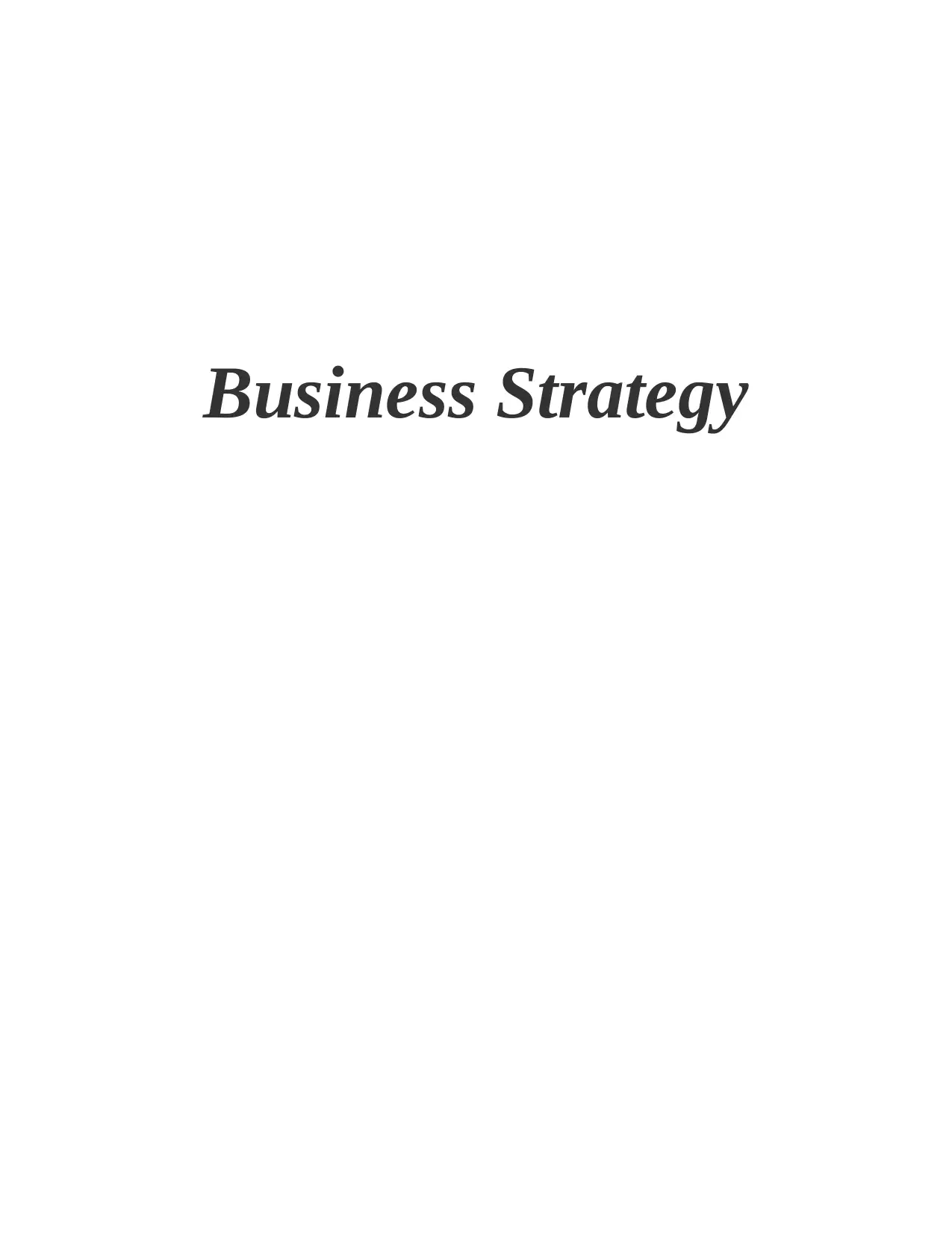
Business Strategy
Paraphrase This Document
Need a fresh take? Get an instant paraphrase of this document with our AI Paraphraser
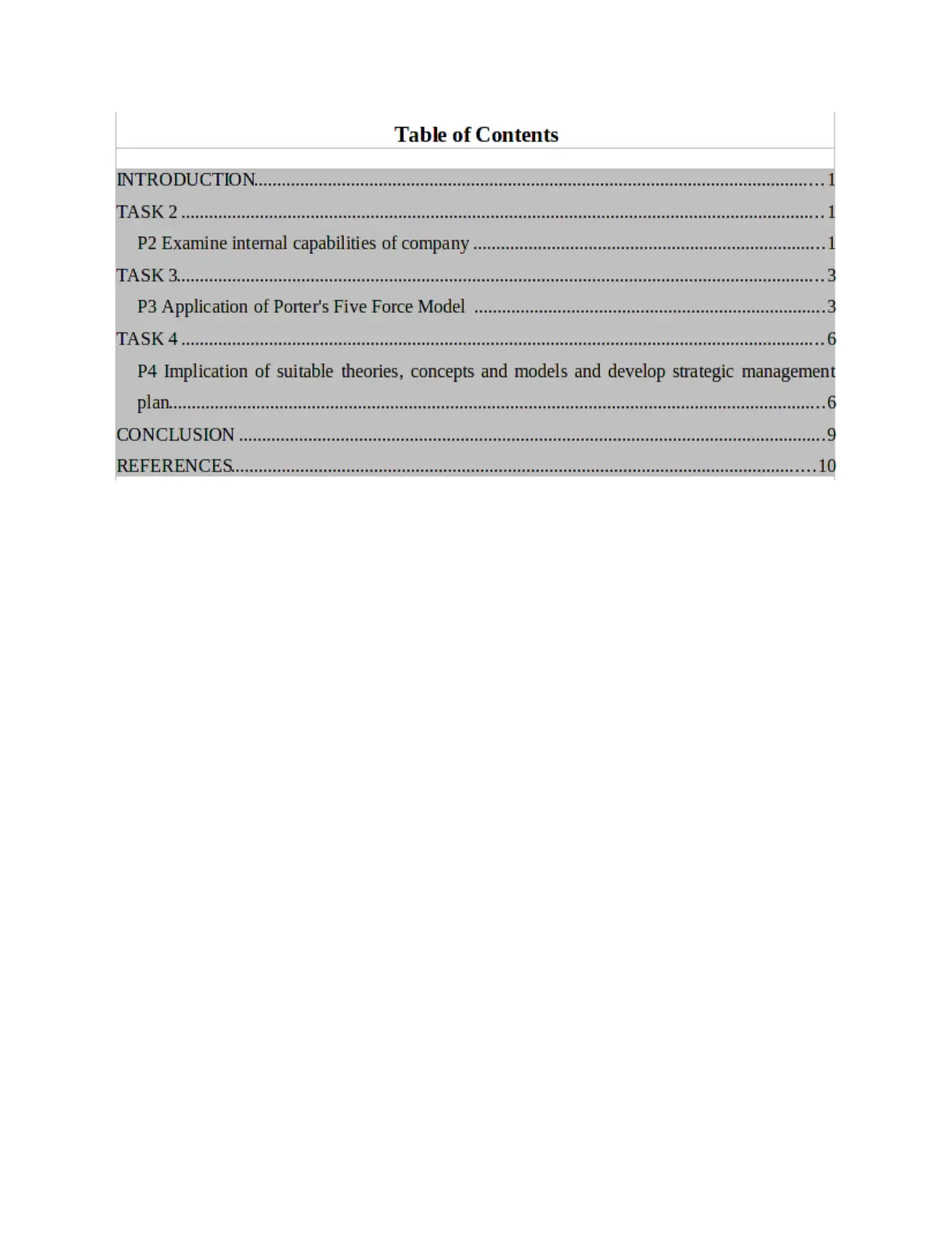
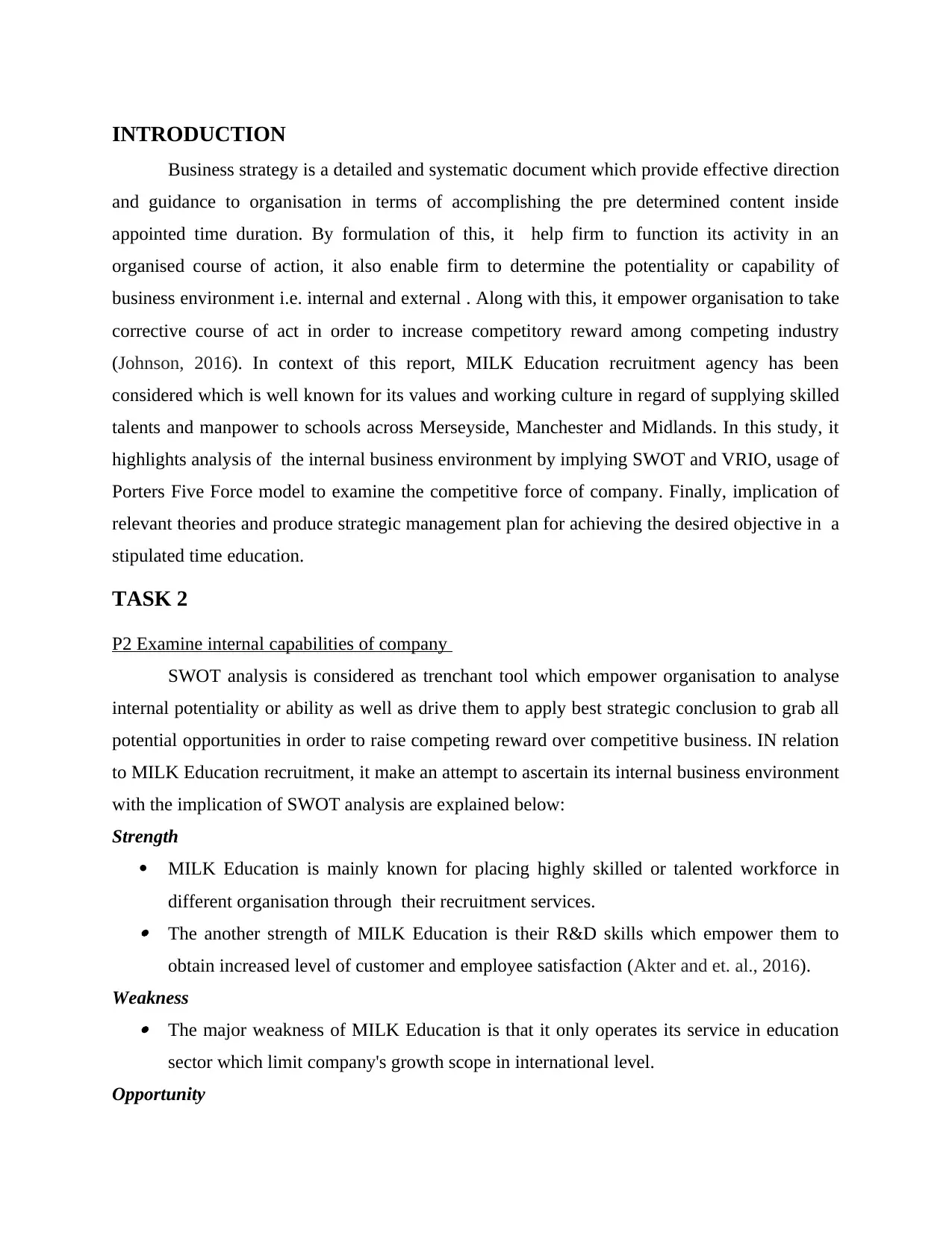
INTRODUCTION
Business strategy is a detailed and systematic document which provide effective direction
and guidance to organisation in terms of accomplishing the pre determined content inside
appointed time duration. By formulation of this, it help firm to function its activity in an
organised course of action, it also enable firm to determine the potentiality or capability of
business environment i.e. internal and external . Along with this, it empower organisation to take
corrective course of act in order to increase competitory reward among competing industry
(Johnson, 2016). In context of this report, MILK Education recruitment agency has been
considered which is well known for its values and working culture in regard of supplying skilled
talents and manpower to schools across Merseyside, Manchester and Midlands. In this study, it
highlights analysis of the internal business environment by implying SWOT and VRIO, usage of
Porters Five Force model to examine the competitive force of company. Finally, implication of
relevant theories and produce strategic management plan for achieving the desired objective in a
stipulated time education.
TASK 2
P2 Examine internal capabilities of company
SWOT analysis is considered as trenchant tool which empower organisation to analyse
internal potentiality or ability as well as drive them to apply best strategic conclusion to grab all
potential opportunities in order to raise competing reward over competitive business. IN relation
to MILK Education recruitment, it make an attempt to ascertain its internal business environment
with the implication of SWOT analysis are explained below:
Strength
MILK Education is mainly known for placing highly skilled or talented workforce in
different organisation through their recruitment services. The another strength of MILK Education is their R&D skills which empower them to
obtain increased level of customer and employee satisfaction (Akter and et. al., 2016).
Weakness The major weakness of MILK Education is that it only operates its service in education
sector which limit company's growth scope in international level.
Opportunity
Business strategy is a detailed and systematic document which provide effective direction
and guidance to organisation in terms of accomplishing the pre determined content inside
appointed time duration. By formulation of this, it help firm to function its activity in an
organised course of action, it also enable firm to determine the potentiality or capability of
business environment i.e. internal and external . Along with this, it empower organisation to take
corrective course of act in order to increase competitory reward among competing industry
(Johnson, 2016). In context of this report, MILK Education recruitment agency has been
considered which is well known for its values and working culture in regard of supplying skilled
talents and manpower to schools across Merseyside, Manchester and Midlands. In this study, it
highlights analysis of the internal business environment by implying SWOT and VRIO, usage of
Porters Five Force model to examine the competitive force of company. Finally, implication of
relevant theories and produce strategic management plan for achieving the desired objective in a
stipulated time education.
TASK 2
P2 Examine internal capabilities of company
SWOT analysis is considered as trenchant tool which empower organisation to analyse
internal potentiality or ability as well as drive them to apply best strategic conclusion to grab all
potential opportunities in order to raise competing reward over competitive business. IN relation
to MILK Education recruitment, it make an attempt to ascertain its internal business environment
with the implication of SWOT analysis are explained below:
Strength
MILK Education is mainly known for placing highly skilled or talented workforce in
different organisation through their recruitment services. The another strength of MILK Education is their R&D skills which empower them to
obtain increased level of customer and employee satisfaction (Akter and et. al., 2016).
Weakness The major weakness of MILK Education is that it only operates its service in education
sector which limit company's growth scope in international level.
Opportunity
⊘ This is a preview!⊘
Do you want full access?
Subscribe today to unlock all pages.

Trusted by 1+ million students worldwide
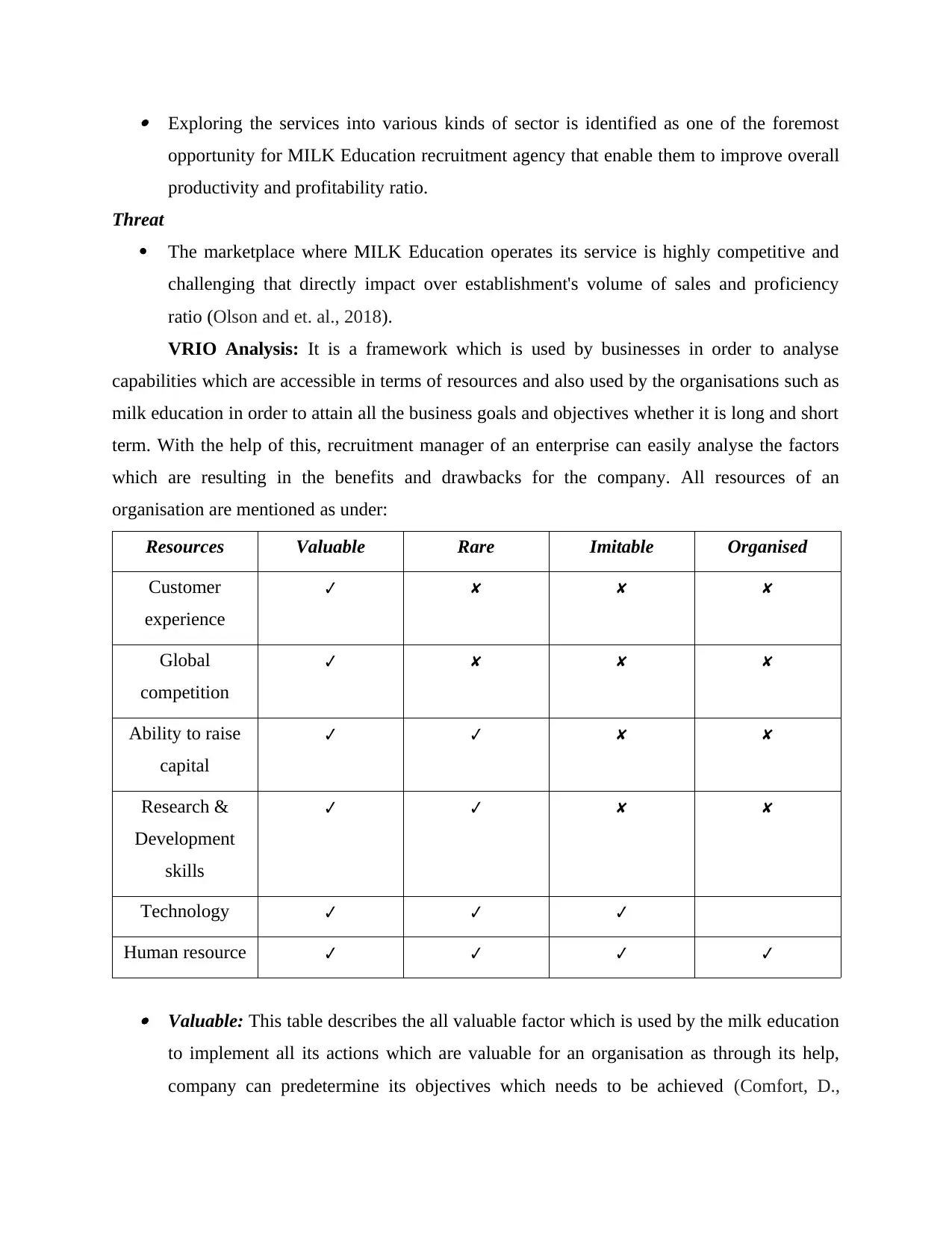
Exploring the services into various kinds of sector is identified as one of the foremost
opportunity for MILK Education recruitment agency that enable them to improve overall
productivity and profitability ratio.
Threat
The marketplace where MILK Education operates its service is highly competitive and
challenging that directly impact over establishment's volume of sales and proficiency
ratio (Olson and et. al., 2018).
VRIO Analysis: It is a framework which is used by businesses in order to analyse
capabilities which are accessible in terms of resources and also used by the organisations such as
milk education in order to attain all the business goals and objectives whether it is long and short
term. With the help of this, recruitment manager of an enterprise can easily analyse the factors
which are resulting in the benefits and drawbacks for the company. All resources of an
organisation are mentioned as under:
Resources Valuable Rare Imitable Organised
Customer
experience
✔ ✘ ✘ ✘
Global
competition
✔ ✘ ✘ ✘
Ability to raise
capital
✔ ✔ ✘ ✘
Research &
Development
skills
✔ ✔ ✘ ✘
Technology ✔ ✔ ✔
Human resource ✔ ✔ ✔ ✔
Valuable: This table describes the all valuable factor which is used by the milk education
to implement all its actions which are valuable for an organisation as through its help,
company can predetermine its objectives which needs to be achieved (Comfort, D.,
opportunity for MILK Education recruitment agency that enable them to improve overall
productivity and profitability ratio.
Threat
The marketplace where MILK Education operates its service is highly competitive and
challenging that directly impact over establishment's volume of sales and proficiency
ratio (Olson and et. al., 2018).
VRIO Analysis: It is a framework which is used by businesses in order to analyse
capabilities which are accessible in terms of resources and also used by the organisations such as
milk education in order to attain all the business goals and objectives whether it is long and short
term. With the help of this, recruitment manager of an enterprise can easily analyse the factors
which are resulting in the benefits and drawbacks for the company. All resources of an
organisation are mentioned as under:
Resources Valuable Rare Imitable Organised
Customer
experience
✔ ✘ ✘ ✘
Global
competition
✔ ✘ ✘ ✘
Ability to raise
capital
✔ ✔ ✘ ✘
Research &
Development
skills
✔ ✔ ✘ ✘
Technology ✔ ✔ ✔
Human resource ✔ ✔ ✔ ✔
Valuable: This table describes the all valuable factor which is used by the milk education
to implement all its actions which are valuable for an organisation as through its help,
company can predetermine its objectives which needs to be achieved (Comfort, D.,
Paraphrase This Document
Need a fresh take? Get an instant paraphrase of this document with our AI Paraphraser
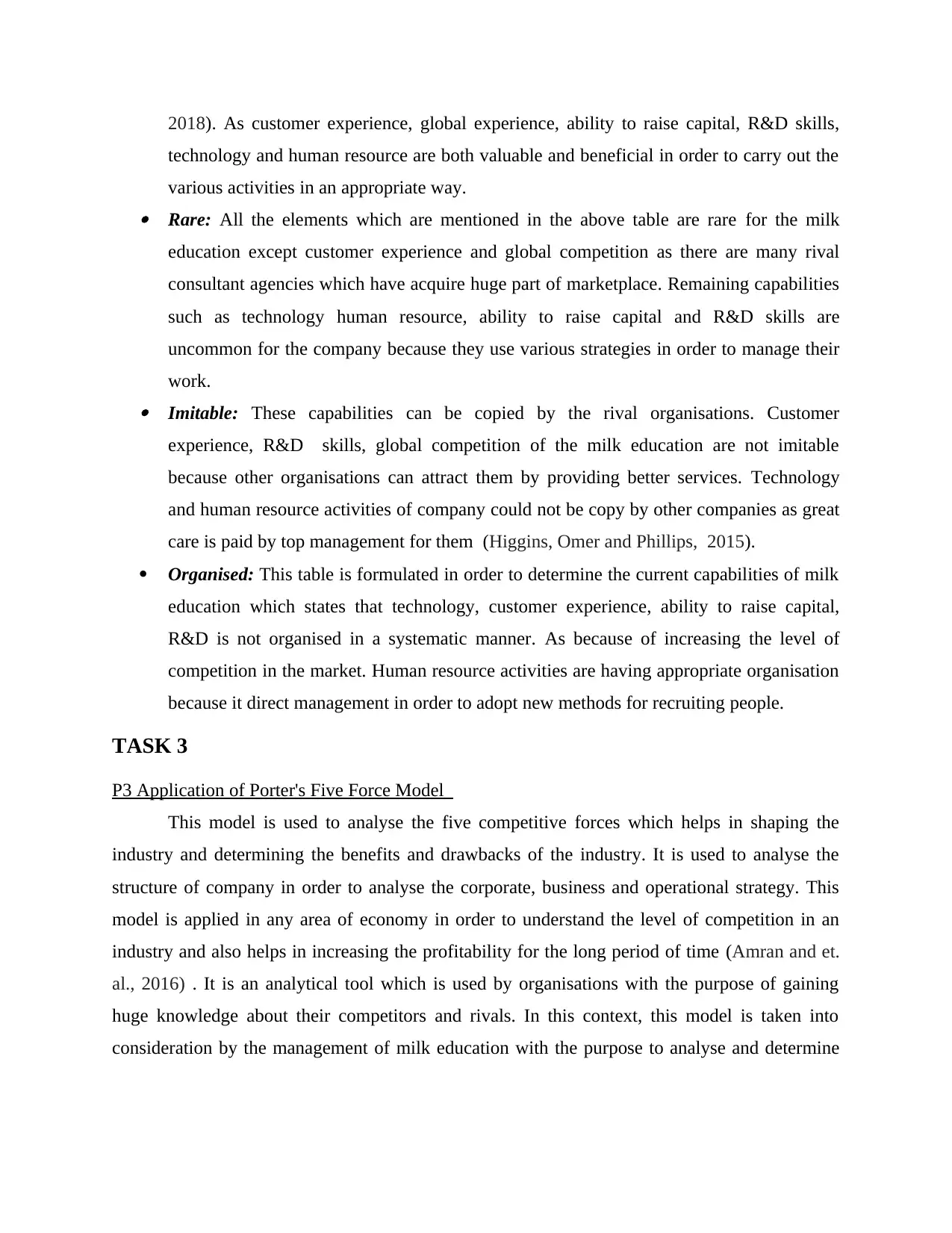
2018). As customer experience, global experience, ability to raise capital, R&D skills,
technology and human resource are both valuable and beneficial in order to carry out the
various activities in an appropriate way. Rare: All the elements which are mentioned in the above table are rare for the milk
education except customer experience and global competition as there are many rival
consultant agencies which have acquire huge part of marketplace. Remaining capabilities
such as technology human resource, ability to raise capital and R&D skills are
uncommon for the company because they use various strategies in order to manage their
work. Imitable: These capabilities can be copied by the rival organisations. Customer
experience, R&D skills, global competition of the milk education are not imitable
because other organisations can attract them by providing better services. Technology
and human resource activities of company could not be copy by other companies as great
care is paid by top management for them (Higgins, Omer and Phillips, 2015).
Organised: This table is formulated in order to determine the current capabilities of milk
education which states that technology, customer experience, ability to raise capital,
R&D is not organised in a systematic manner. As because of increasing the level of
competition in the market. Human resource activities are having appropriate organisation
because it direct management in order to adopt new methods for recruiting people.
TASK 3
P3 Application of Porter's Five Force Model
This model is used to analyse the five competitive forces which helps in shaping the
industry and determining the benefits and drawbacks of the industry. It is used to analyse the
structure of company in order to analyse the corporate, business and operational strategy. This
model is applied in any area of economy in order to understand the level of competition in an
industry and also helps in increasing the profitability for the long period of time (Amran and et.
al., 2016) . It is an analytical tool which is used by organisations with the purpose of gaining
huge knowledge about their competitors and rivals. In this context, this model is taken into
consideration by the management of milk education with the purpose to analyse and determine
technology and human resource are both valuable and beneficial in order to carry out the
various activities in an appropriate way. Rare: All the elements which are mentioned in the above table are rare for the milk
education except customer experience and global competition as there are many rival
consultant agencies which have acquire huge part of marketplace. Remaining capabilities
such as technology human resource, ability to raise capital and R&D skills are
uncommon for the company because they use various strategies in order to manage their
work. Imitable: These capabilities can be copied by the rival organisations. Customer
experience, R&D skills, global competition of the milk education are not imitable
because other organisations can attract them by providing better services. Technology
and human resource activities of company could not be copy by other companies as great
care is paid by top management for them (Higgins, Omer and Phillips, 2015).
Organised: This table is formulated in order to determine the current capabilities of milk
education which states that technology, customer experience, ability to raise capital,
R&D is not organised in a systematic manner. As because of increasing the level of
competition in the market. Human resource activities are having appropriate organisation
because it direct management in order to adopt new methods for recruiting people.
TASK 3
P3 Application of Porter's Five Force Model
This model is used to analyse the five competitive forces which helps in shaping the
industry and determining the benefits and drawbacks of the industry. It is used to analyse the
structure of company in order to analyse the corporate, business and operational strategy. This
model is applied in any area of economy in order to understand the level of competition in an
industry and also helps in increasing the profitability for the long period of time (Amran and et.
al., 2016) . It is an analytical tool which is used by organisations with the purpose of gaining
huge knowledge about their competitors and rivals. In this context, this model is taken into
consideration by the management of milk education with the purpose to analyse and determine
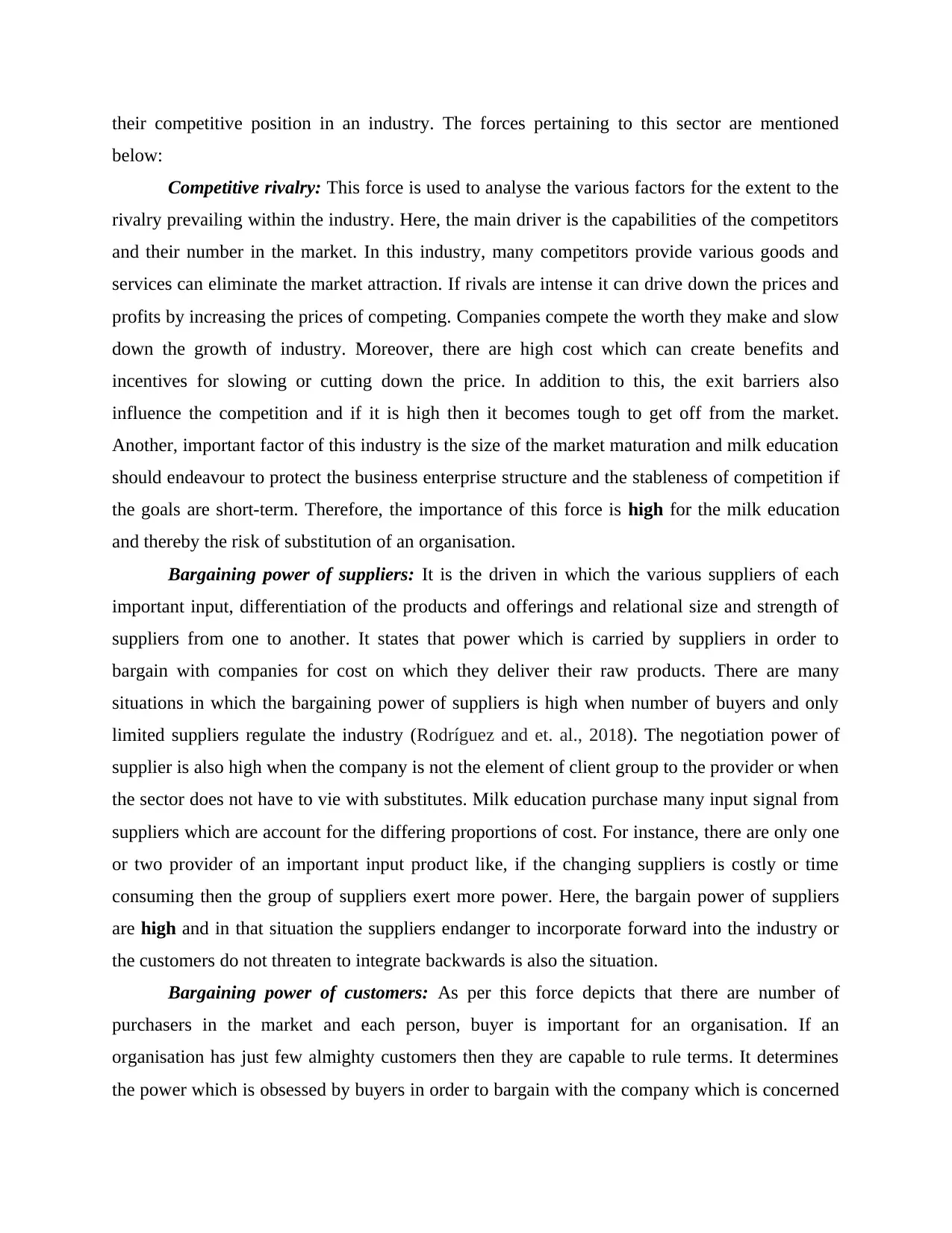
their competitive position in an industry. The forces pertaining to this sector are mentioned
below:
Competitive rivalry: This force is used to analyse the various factors for the extent to the
rivalry prevailing within the industry. Here, the main driver is the capabilities of the competitors
and their number in the market. In this industry, many competitors provide various goods and
services can eliminate the market attraction. If rivals are intense it can drive down the prices and
profits by increasing the prices of competing. Companies compete the worth they make and slow
down the growth of industry. Moreover, there are high cost which can create benefits and
incentives for slowing or cutting down the price. In addition to this, the exit barriers also
influence the competition and if it is high then it becomes tough to get off from the market.
Another, important factor of this industry is the size of the market maturation and milk education
should endeavour to protect the business enterprise structure and the stableness of competition if
the goals are short-term. Therefore, the importance of this force is high for the milk education
and thereby the risk of substitution of an organisation.
Bargaining power of suppliers: It is the driven in which the various suppliers of each
important input, differentiation of the products and offerings and relational size and strength of
suppliers from one to another. It states that power which is carried by suppliers in order to
bargain with companies for cost on which they deliver their raw products. There are many
situations in which the bargaining power of suppliers is high when number of buyers and only
limited suppliers regulate the industry (Rodríguez and et. al., 2018). The negotiation power of
supplier is also high when the company is not the element of client group to the provider or when
the sector does not have to vie with substitutes. Milk education purchase many input signal from
suppliers which are account for the differing proportions of cost. For instance, there are only one
or two provider of an important input product like, if the changing suppliers is costly or time
consuming then the group of suppliers exert more power. Here, the bargain power of suppliers
are high and in that situation the suppliers endanger to incorporate forward into the industry or
the customers do not threaten to integrate backwards is also the situation.
Bargaining power of customers: As per this force depicts that there are number of
purchasers in the market and each person, buyer is important for an organisation. If an
organisation has just few almighty customers then they are capable to rule terms. It determines
the power which is obsessed by buyers in order to bargain with the company which is concerned
below:
Competitive rivalry: This force is used to analyse the various factors for the extent to the
rivalry prevailing within the industry. Here, the main driver is the capabilities of the competitors
and their number in the market. In this industry, many competitors provide various goods and
services can eliminate the market attraction. If rivals are intense it can drive down the prices and
profits by increasing the prices of competing. Companies compete the worth they make and slow
down the growth of industry. Moreover, there are high cost which can create benefits and
incentives for slowing or cutting down the price. In addition to this, the exit barriers also
influence the competition and if it is high then it becomes tough to get off from the market.
Another, important factor of this industry is the size of the market maturation and milk education
should endeavour to protect the business enterprise structure and the stableness of competition if
the goals are short-term. Therefore, the importance of this force is high for the milk education
and thereby the risk of substitution of an organisation.
Bargaining power of suppliers: It is the driven in which the various suppliers of each
important input, differentiation of the products and offerings and relational size and strength of
suppliers from one to another. It states that power which is carried by suppliers in order to
bargain with companies for cost on which they deliver their raw products. There are many
situations in which the bargaining power of suppliers is high when number of buyers and only
limited suppliers regulate the industry (Rodríguez and et. al., 2018). The negotiation power of
supplier is also high when the company is not the element of client group to the provider or when
the sector does not have to vie with substitutes. Milk education purchase many input signal from
suppliers which are account for the differing proportions of cost. For instance, there are only one
or two provider of an important input product like, if the changing suppliers is costly or time
consuming then the group of suppliers exert more power. Here, the bargain power of suppliers
are high and in that situation the suppliers endanger to incorporate forward into the industry or
the customers do not threaten to integrate backwards is also the situation.
Bargaining power of customers: As per this force depicts that there are number of
purchasers in the market and each person, buyer is important for an organisation. If an
organisation has just few almighty customers then they are capable to rule terms. It determines
the power which is obsessed by buyers in order to bargain with the company which is concerned
⊘ This is a preview!⊘
Do you want full access?
Subscribe today to unlock all pages.

Trusted by 1+ million students worldwide
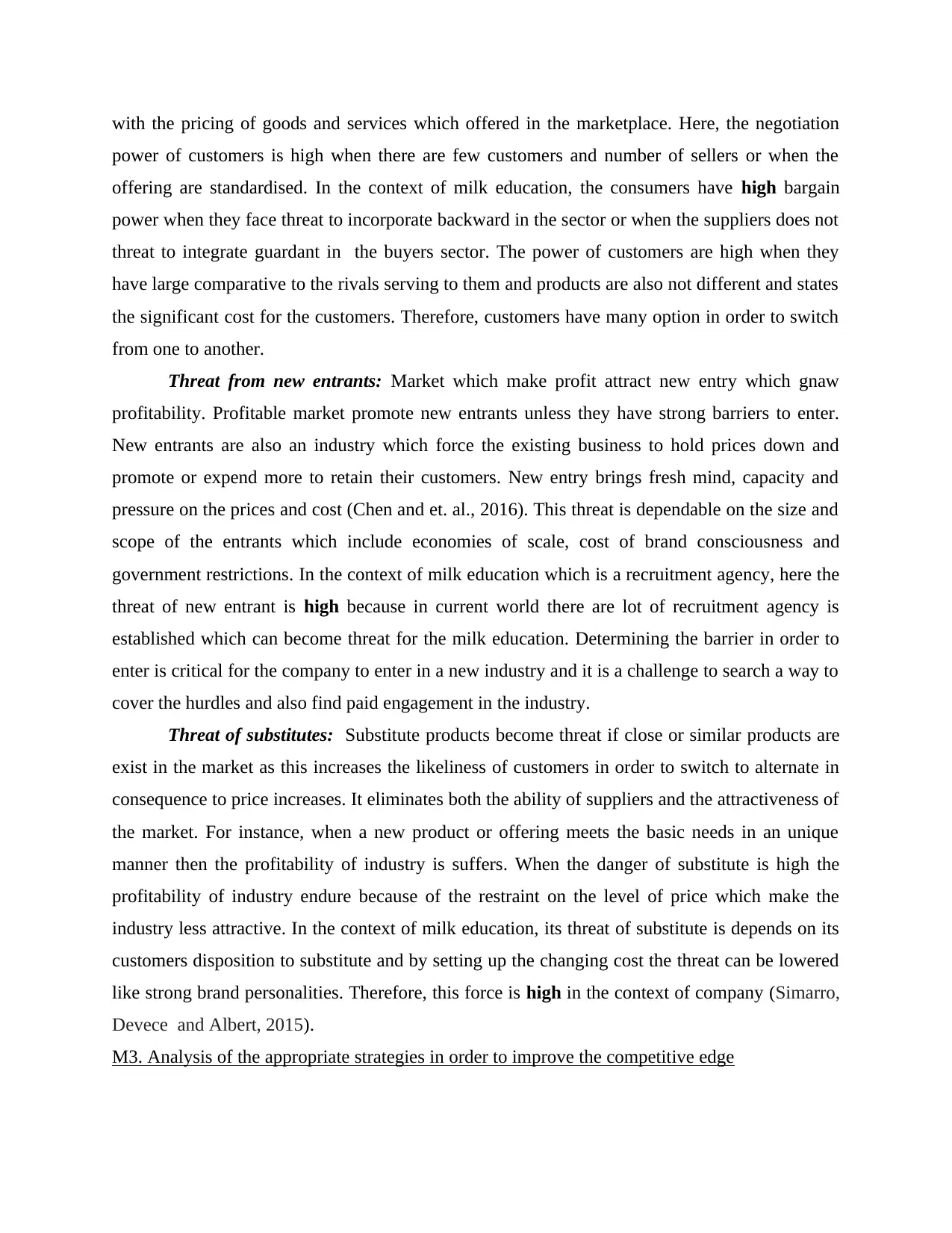
with the pricing of goods and services which offered in the marketplace. Here, the negotiation
power of customers is high when there are few customers and number of sellers or when the
offering are standardised. In the context of milk education, the consumers have high bargain
power when they face threat to incorporate backward in the sector or when the suppliers does not
threat to integrate guardant in the buyers sector. The power of customers are high when they
have large comparative to the rivals serving to them and products are also not different and states
the significant cost for the customers. Therefore, customers have many option in order to switch
from one to another.
Threat from new entrants: Market which make profit attract new entry which gnaw
profitability. Profitable market promote new entrants unless they have strong barriers to enter.
New entrants are also an industry which force the existing business to hold prices down and
promote or expend more to retain their customers. New entry brings fresh mind, capacity and
pressure on the prices and cost (Chen and et. al., 2016). This threat is dependable on the size and
scope of the entrants which include economies of scale, cost of brand consciousness and
government restrictions. In the context of milk education which is a recruitment agency, here the
threat of new entrant is high because in current world there are lot of recruitment agency is
established which can become threat for the milk education. Determining the barrier in order to
enter is critical for the company to enter in a new industry and it is a challenge to search a way to
cover the hurdles and also find paid engagement in the industry.
Threat of substitutes: Substitute products become threat if close or similar products are
exist in the market as this increases the likeliness of customers in order to switch to alternate in
consequence to price increases. It eliminates both the ability of suppliers and the attractiveness of
the market. For instance, when a new product or offering meets the basic needs in an unique
manner then the profitability of industry is suffers. When the danger of substitute is high the
profitability of industry endure because of the restraint on the level of price which make the
industry less attractive. In the context of milk education, its threat of substitute is depends on its
customers disposition to substitute and by setting up the changing cost the threat can be lowered
like strong brand personalities. Therefore, this force is high in the context of company (Simarro,
Devece and Albert, 2015).
M3. Analysis of the appropriate strategies in order to improve the competitive edge
power of customers is high when there are few customers and number of sellers or when the
offering are standardised. In the context of milk education, the consumers have high bargain
power when they face threat to incorporate backward in the sector or when the suppliers does not
threat to integrate guardant in the buyers sector. The power of customers are high when they
have large comparative to the rivals serving to them and products are also not different and states
the significant cost for the customers. Therefore, customers have many option in order to switch
from one to another.
Threat from new entrants: Market which make profit attract new entry which gnaw
profitability. Profitable market promote new entrants unless they have strong barriers to enter.
New entrants are also an industry which force the existing business to hold prices down and
promote or expend more to retain their customers. New entry brings fresh mind, capacity and
pressure on the prices and cost (Chen and et. al., 2016). This threat is dependable on the size and
scope of the entrants which include economies of scale, cost of brand consciousness and
government restrictions. In the context of milk education which is a recruitment agency, here the
threat of new entrant is high because in current world there are lot of recruitment agency is
established which can become threat for the milk education. Determining the barrier in order to
enter is critical for the company to enter in a new industry and it is a challenge to search a way to
cover the hurdles and also find paid engagement in the industry.
Threat of substitutes: Substitute products become threat if close or similar products are
exist in the market as this increases the likeliness of customers in order to switch to alternate in
consequence to price increases. It eliminates both the ability of suppliers and the attractiveness of
the market. For instance, when a new product or offering meets the basic needs in an unique
manner then the profitability of industry is suffers. When the danger of substitute is high the
profitability of industry endure because of the restraint on the level of price which make the
industry less attractive. In the context of milk education, its threat of substitute is depends on its
customers disposition to substitute and by setting up the changing cost the threat can be lowered
like strong brand personalities. Therefore, this force is high in the context of company (Simarro,
Devece and Albert, 2015).
M3. Analysis of the appropriate strategies in order to improve the competitive edge
Paraphrase This Document
Need a fresh take? Get an instant paraphrase of this document with our AI Paraphraser
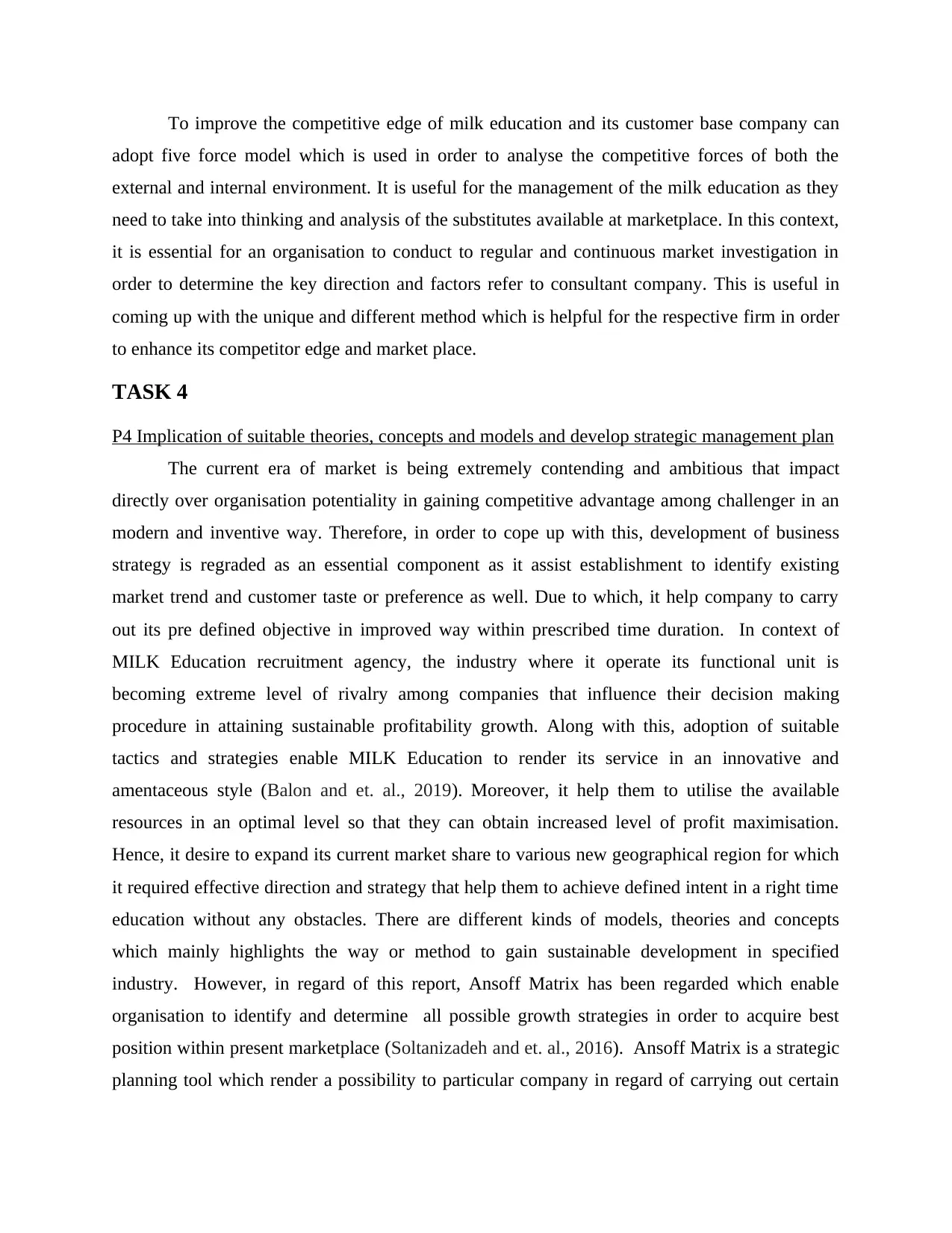
To improve the competitive edge of milk education and its customer base company can
adopt five force model which is used in order to analyse the competitive forces of both the
external and internal environment. It is useful for the management of the milk education as they
need to take into thinking and analysis of the substitutes available at marketplace. In this context,
it is essential for an organisation to conduct to regular and continuous market investigation in
order to determine the key direction and factors refer to consultant company. This is useful in
coming up with the unique and different method which is helpful for the respective firm in order
to enhance its competitor edge and market place.
TASK 4
P4 Implication of suitable theories, concepts and models and develop strategic management plan
The current era of market is being extremely contending and ambitious that impact
directly over organisation potentiality in gaining competitive advantage among challenger in an
modern and inventive way. Therefore, in order to cope up with this, development of business
strategy is regraded as an essential component as it assist establishment to identify existing
market trend and customer taste or preference as well. Due to which, it help company to carry
out its pre defined objective in improved way within prescribed time duration. In context of
MILK Education recruitment agency, the industry where it operate its functional unit is
becoming extreme level of rivalry among companies that influence their decision making
procedure in attaining sustainable profitability growth. Along with this, adoption of suitable
tactics and strategies enable MILK Education to render its service in an innovative and
amentaceous style (Balon and et. al., 2019). Moreover, it help them to utilise the available
resources in an optimal level so that they can obtain increased level of profit maximisation.
Hence, it desire to expand its current market share to various new geographical region for which
it required effective direction and strategy that help them to achieve defined intent in a right time
education without any obstacles. There are different kinds of models, theories and concepts
which mainly highlights the way or method to gain sustainable development in specified
industry. However, in regard of this report, Ansoff Matrix has been regarded which enable
organisation to identify and determine all possible growth strategies in order to acquire best
position within present marketplace (Soltanizadeh and et. al., 2016). Ansoff Matrix is a strategic
planning tool which render a possibility to particular company in regard of carrying out certain
adopt five force model which is used in order to analyse the competitive forces of both the
external and internal environment. It is useful for the management of the milk education as they
need to take into thinking and analysis of the substitutes available at marketplace. In this context,
it is essential for an organisation to conduct to regular and continuous market investigation in
order to determine the key direction and factors refer to consultant company. This is useful in
coming up with the unique and different method which is helpful for the respective firm in order
to enhance its competitor edge and market place.
TASK 4
P4 Implication of suitable theories, concepts and models and develop strategic management plan
The current era of market is being extremely contending and ambitious that impact
directly over organisation potentiality in gaining competitive advantage among challenger in an
modern and inventive way. Therefore, in order to cope up with this, development of business
strategy is regraded as an essential component as it assist establishment to identify existing
market trend and customer taste or preference as well. Due to which, it help company to carry
out its pre defined objective in improved way within prescribed time duration. In context of
MILK Education recruitment agency, the industry where it operate its functional unit is
becoming extreme level of rivalry among companies that influence their decision making
procedure in attaining sustainable profitability growth. Along with this, adoption of suitable
tactics and strategies enable MILK Education to render its service in an innovative and
amentaceous style (Balon and et. al., 2019). Moreover, it help them to utilise the available
resources in an optimal level so that they can obtain increased level of profit maximisation.
Hence, it desire to expand its current market share to various new geographical region for which
it required effective direction and strategy that help them to achieve defined intent in a right time
education without any obstacles. There are different kinds of models, theories and concepts
which mainly highlights the way or method to gain sustainable development in specified
industry. However, in regard of this report, Ansoff Matrix has been regarded which enable
organisation to identify and determine all possible growth strategies in order to acquire best
position within present marketplace (Soltanizadeh and et. al., 2016). Ansoff Matrix is a strategic
planning tool which render a possibility to particular company in regard of carrying out certain
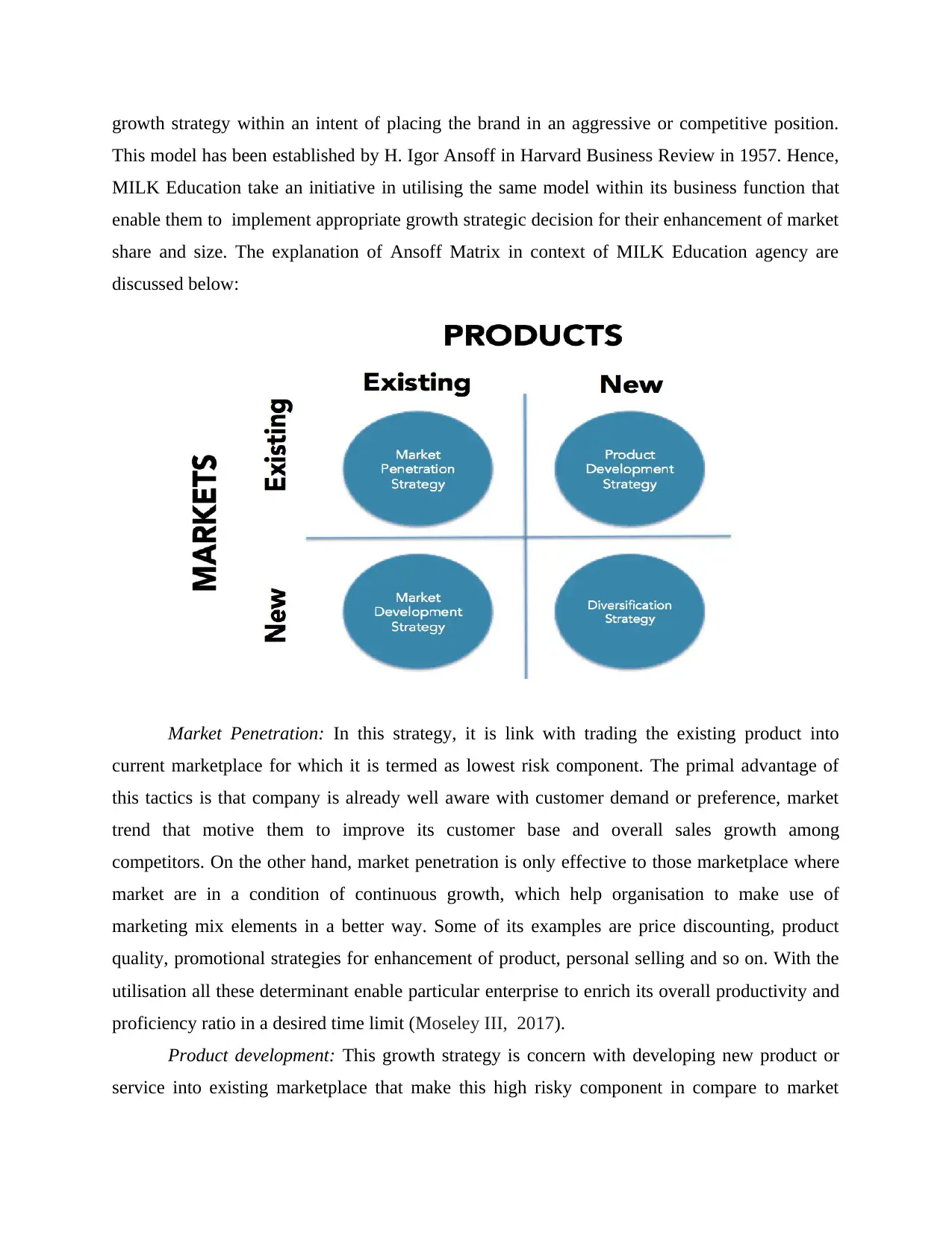
growth strategy within an intent of placing the brand in an aggressive or competitive position.
This model has been established by H. Igor Ansoff in Harvard Business Review in 1957. Hence,
MILK Education take an initiative in utilising the same model within its business function that
enable them to implement appropriate growth strategic decision for their enhancement of market
share and size. The explanation of Ansoff Matrix in context of MILK Education agency are
discussed below:
Market Penetration: In this strategy, it is link with trading the existing product into
current marketplace for which it is termed as lowest risk component. The primal advantage of
this tactics is that company is already well aware with customer demand or preference, market
trend that motive them to improve its customer base and overall sales growth among
competitors. On the other hand, market penetration is only effective to those marketplace where
market are in a condition of continuous growth, which help organisation to make use of
marketing mix elements in a better way. Some of its examples are price discounting, product
quality, promotional strategies for enhancement of product, personal selling and so on. With the
utilisation all these determinant enable particular enterprise to enrich its overall productivity and
proficiency ratio in a desired time limit (Moseley III, 2017).
Product development: This growth strategy is concern with developing new product or
service into existing marketplace that make this high risky component in compare to market
This model has been established by H. Igor Ansoff in Harvard Business Review in 1957. Hence,
MILK Education take an initiative in utilising the same model within its business function that
enable them to implement appropriate growth strategic decision for their enhancement of market
share and size. The explanation of Ansoff Matrix in context of MILK Education agency are
discussed below:
Market Penetration: In this strategy, it is link with trading the existing product into
current marketplace for which it is termed as lowest risk component. The primal advantage of
this tactics is that company is already well aware with customer demand or preference, market
trend that motive them to improve its customer base and overall sales growth among
competitors. On the other hand, market penetration is only effective to those marketplace where
market are in a condition of continuous growth, which help organisation to make use of
marketing mix elements in a better way. Some of its examples are price discounting, product
quality, promotional strategies for enhancement of product, personal selling and so on. With the
utilisation all these determinant enable particular enterprise to enrich its overall productivity and
proficiency ratio in a desired time limit (Moseley III, 2017).
Product development: This growth strategy is concern with developing new product or
service into existing marketplace that make this high risky component in compare to market
⊘ This is a preview!⊘
Do you want full access?
Subscribe today to unlock all pages.

Trusted by 1+ million students worldwide
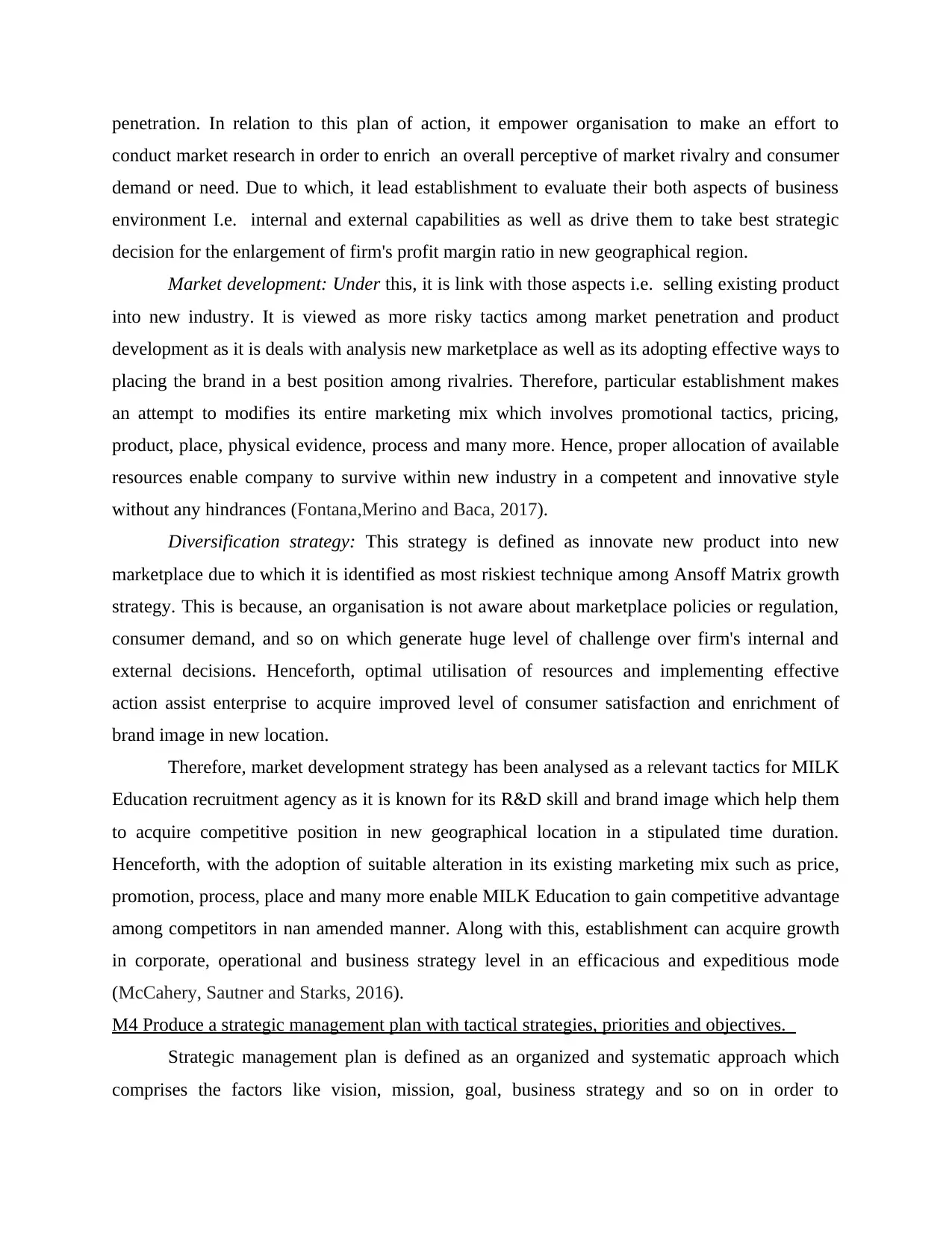
penetration. In relation to this plan of action, it empower organisation to make an effort to
conduct market research in order to enrich an overall perceptive of market rivalry and consumer
demand or need. Due to which, it lead establishment to evaluate their both aspects of business
environment I.e. internal and external capabilities as well as drive them to take best strategic
decision for the enlargement of firm's profit margin ratio in new geographical region.
Market development: Under this, it is link with those aspects i.e. selling existing product
into new industry. It is viewed as more risky tactics among market penetration and product
development as it is deals with analysis new marketplace as well as its adopting effective ways to
placing the brand in a best position among rivalries. Therefore, particular establishment makes
an attempt to modifies its entire marketing mix which involves promotional tactics, pricing,
product, place, physical evidence, process and many more. Hence, proper allocation of available
resources enable company to survive within new industry in a competent and innovative style
without any hindrances (Fontana,Merino and Baca, 2017).
Diversification strategy: This strategy is defined as innovate new product into new
marketplace due to which it is identified as most riskiest technique among Ansoff Matrix growth
strategy. This is because, an organisation is not aware about marketplace policies or regulation,
consumer demand, and so on which generate huge level of challenge over firm's internal and
external decisions. Henceforth, optimal utilisation of resources and implementing effective
action assist enterprise to acquire improved level of consumer satisfaction and enrichment of
brand image in new location.
Therefore, market development strategy has been analysed as a relevant tactics for MILK
Education recruitment agency as it is known for its R&D skill and brand image which help them
to acquire competitive position in new geographical location in a stipulated time duration.
Henceforth, with the adoption of suitable alteration in its existing marketing mix such as price,
promotion, process, place and many more enable MILK Education to gain competitive advantage
among competitors in nan amended manner. Along with this, establishment can acquire growth
in corporate, operational and business strategy level in an efficacious and expeditious mode
(McCahery, Sautner and Starks, 2016).
M4 Produce a strategic management plan with tactical strategies, priorities and objectives.
Strategic management plan is defined as an organized and systematic approach which
comprises the factors like vision, mission, goal, business strategy and so on in order to
conduct market research in order to enrich an overall perceptive of market rivalry and consumer
demand or need. Due to which, it lead establishment to evaluate their both aspects of business
environment I.e. internal and external capabilities as well as drive them to take best strategic
decision for the enlargement of firm's profit margin ratio in new geographical region.
Market development: Under this, it is link with those aspects i.e. selling existing product
into new industry. It is viewed as more risky tactics among market penetration and product
development as it is deals with analysis new marketplace as well as its adopting effective ways to
placing the brand in a best position among rivalries. Therefore, particular establishment makes
an attempt to modifies its entire marketing mix which involves promotional tactics, pricing,
product, place, physical evidence, process and many more. Hence, proper allocation of available
resources enable company to survive within new industry in a competent and innovative style
without any hindrances (Fontana,Merino and Baca, 2017).
Diversification strategy: This strategy is defined as innovate new product into new
marketplace due to which it is identified as most riskiest technique among Ansoff Matrix growth
strategy. This is because, an organisation is not aware about marketplace policies or regulation,
consumer demand, and so on which generate huge level of challenge over firm's internal and
external decisions. Henceforth, optimal utilisation of resources and implementing effective
action assist enterprise to acquire improved level of consumer satisfaction and enrichment of
brand image in new location.
Therefore, market development strategy has been analysed as a relevant tactics for MILK
Education recruitment agency as it is known for its R&D skill and brand image which help them
to acquire competitive position in new geographical location in a stipulated time duration.
Henceforth, with the adoption of suitable alteration in its existing marketing mix such as price,
promotion, process, place and many more enable MILK Education to gain competitive advantage
among competitors in nan amended manner. Along with this, establishment can acquire growth
in corporate, operational and business strategy level in an efficacious and expeditious mode
(McCahery, Sautner and Starks, 2016).
M4 Produce a strategic management plan with tactical strategies, priorities and objectives.
Strategic management plan is defined as an organized and systematic approach which
comprises the factors like vision, mission, goal, business strategy and so on in order to
Paraphrase This Document
Need a fresh take? Get an instant paraphrase of this document with our AI Paraphraser
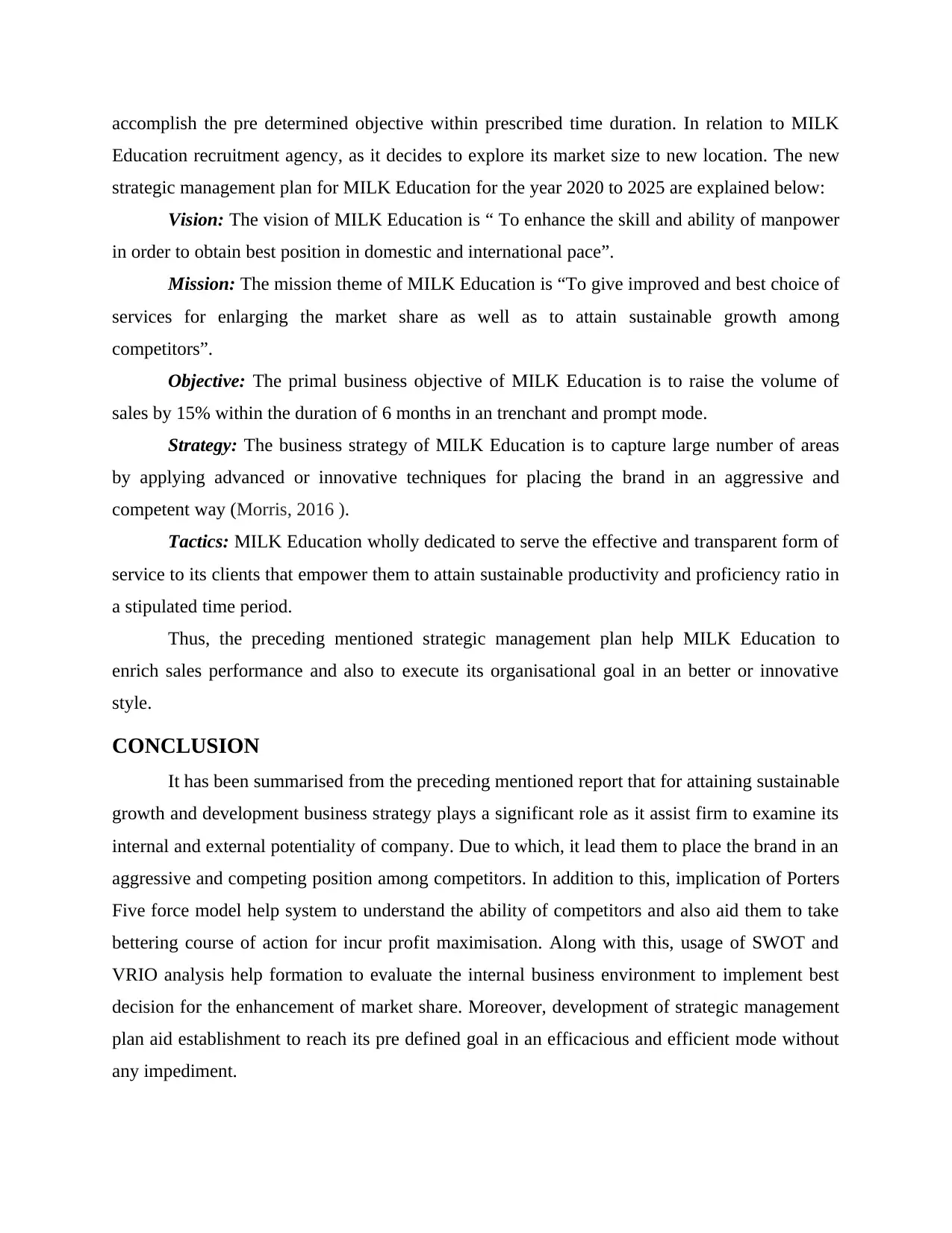
accomplish the pre determined objective within prescribed time duration. In relation to MILK
Education recruitment agency, as it decides to explore its market size to new location. The new
strategic management plan for MILK Education for the year 2020 to 2025 are explained below:
Vision: The vision of MILK Education is “ To enhance the skill and ability of manpower
in order to obtain best position in domestic and international pace”.
Mission: The mission theme of MILK Education is “To give improved and best choice of
services for enlarging the market share as well as to attain sustainable growth among
competitors”.
Objective: The primal business objective of MILK Education is to raise the volume of
sales by 15% within the duration of 6 months in an trenchant and prompt mode.
Strategy: The business strategy of MILK Education is to capture large number of areas
by applying advanced or innovative techniques for placing the brand in an aggressive and
competent way (Morris, 2016 ).
Tactics: MILK Education wholly dedicated to serve the effective and transparent form of
service to its clients that empower them to attain sustainable productivity and proficiency ratio in
a stipulated time period.
Thus, the preceding mentioned strategic management plan help MILK Education to
enrich sales performance and also to execute its organisational goal in an better or innovative
style.
CONCLUSION
It has been summarised from the preceding mentioned report that for attaining sustainable
growth and development business strategy plays a significant role as it assist firm to examine its
internal and external potentiality of company. Due to which, it lead them to place the brand in an
aggressive and competing position among competitors. In addition to this, implication of Porters
Five force model help system to understand the ability of competitors and also aid them to take
bettering course of action for incur profit maximisation. Along with this, usage of SWOT and
VRIO analysis help formation to evaluate the internal business environment to implement best
decision for the enhancement of market share. Moreover, development of strategic management
plan aid establishment to reach its pre defined goal in an efficacious and efficient mode without
any impediment.
Education recruitment agency, as it decides to explore its market size to new location. The new
strategic management plan for MILK Education for the year 2020 to 2025 are explained below:
Vision: The vision of MILK Education is “ To enhance the skill and ability of manpower
in order to obtain best position in domestic and international pace”.
Mission: The mission theme of MILK Education is “To give improved and best choice of
services for enlarging the market share as well as to attain sustainable growth among
competitors”.
Objective: The primal business objective of MILK Education is to raise the volume of
sales by 15% within the duration of 6 months in an trenchant and prompt mode.
Strategy: The business strategy of MILK Education is to capture large number of areas
by applying advanced or innovative techniques for placing the brand in an aggressive and
competent way (Morris, 2016 ).
Tactics: MILK Education wholly dedicated to serve the effective and transparent form of
service to its clients that empower them to attain sustainable productivity and proficiency ratio in
a stipulated time period.
Thus, the preceding mentioned strategic management plan help MILK Education to
enrich sales performance and also to execute its organisational goal in an better or innovative
style.
CONCLUSION
It has been summarised from the preceding mentioned report that for attaining sustainable
growth and development business strategy plays a significant role as it assist firm to examine its
internal and external potentiality of company. Due to which, it lead them to place the brand in an
aggressive and competing position among competitors. In addition to this, implication of Porters
Five force model help system to understand the ability of competitors and also aid them to take
bettering course of action for incur profit maximisation. Along with this, usage of SWOT and
VRIO analysis help formation to evaluate the internal business environment to implement best
decision for the enhancement of market share. Moreover, development of strategic management
plan aid establishment to reach its pre defined goal in an efficacious and efficient mode without
any impediment.
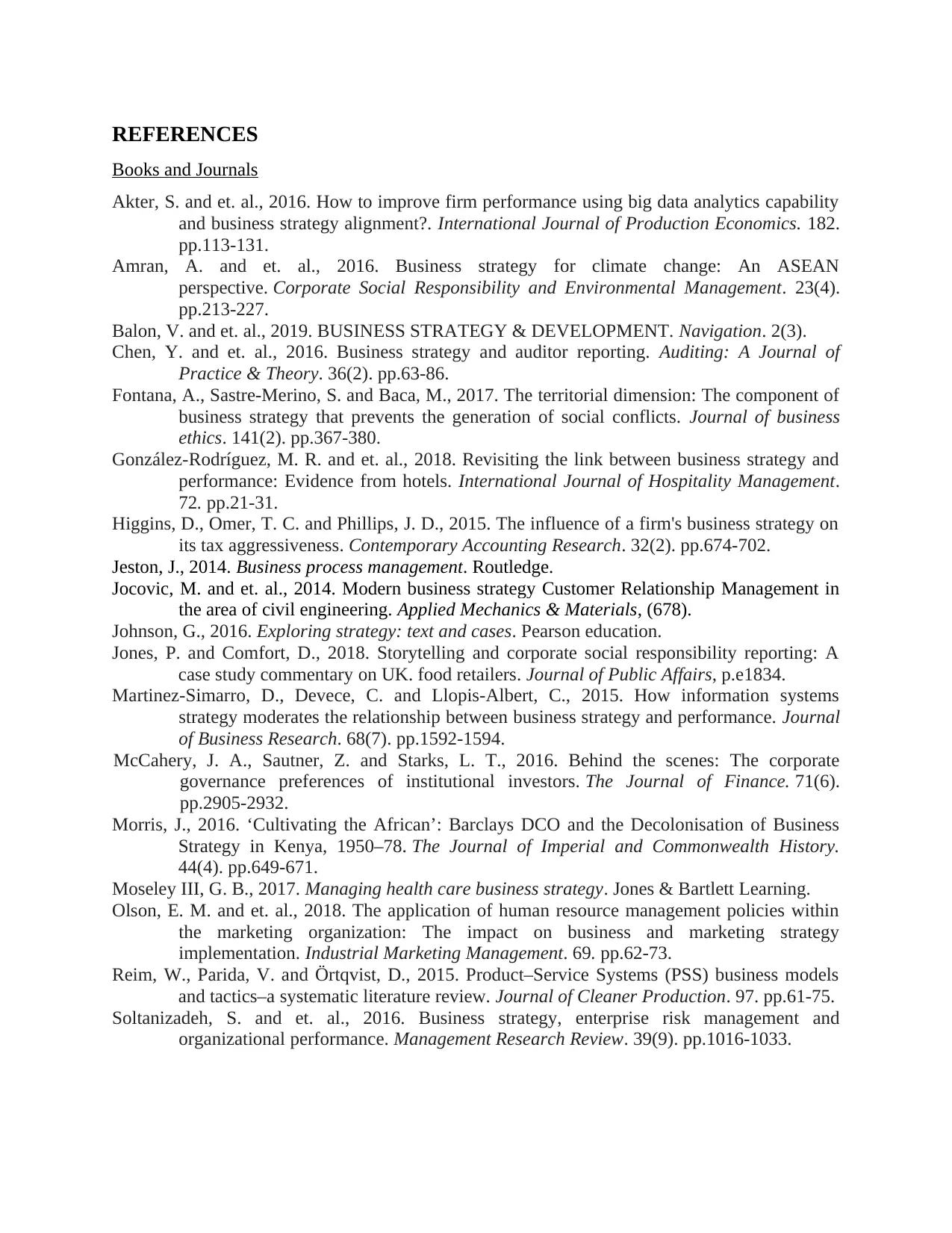
REFERENCES
Books and Journals
Akter, S. and et. al., 2016. How to improve firm performance using big data analytics capability
and business strategy alignment?. International Journal of Production Economics. 182.
pp.113-131.
Amran, A. and et. al., 2016. Business strategy for climate change: An ASEAN
perspective. Corporate Social Responsibility and Environmental Management. 23(4).
pp.213-227.
Balon, V. and et. al., 2019. BUSINESS STRATEGY & DEVELOPMENT. Navigation. 2(3).
Chen, Y. and et. al., 2016. Business strategy and auditor reporting. Auditing: A Journal of
Practice & Theory. 36(2). pp.63-86.
Fontana, A., Sastre-Merino, S. and Baca, M., 2017. The territorial dimension: The component of
business strategy that prevents the generation of social conflicts. Journal of business
ethics. 141(2). pp.367-380.
González-Rodríguez, M. R. and et. al., 2018. Revisiting the link between business strategy and
performance: Evidence from hotels. International Journal of Hospitality Management.
72. pp.21-31.
Higgins, D., Omer, T. C. and Phillips, J. D., 2015. The influence of a firm's business strategy on
its tax aggressiveness. Contemporary Accounting Research. 32(2). pp.674-702.
Jeston, J., 2014. Business process management. Routledge.
Jocovic, M. and et. al., 2014. Modern business strategy Customer Relationship Management in
the area of civil engineering. Applied Mechanics & Materials, (678).
Johnson, G., 2016. Exploring strategy: text and cases. Pearson education.
Jones, P. and Comfort, D., 2018. Storytelling and corporate social responsibility reporting: A
case study commentary on UK. food retailers. Journal of Public Affairs, p.e1834.
Martinez-Simarro, D., Devece, C. and Llopis-Albert, C., 2015. How information systems
strategy moderates the relationship between business strategy and performance. Journal
of Business Research. 68(7). pp.1592-1594.
McCahery, J. A., Sautner, Z. and Starks, L. T., 2016. Behind the scenes: The corporate
governance preferences of institutional investors. The Journal of Finance. 71(6).
pp.2905-2932.
Morris, J., 2016. ‘Cultivating the African’: Barclays DCO and the Decolonisation of Business
Strategy in Kenya, 1950–78. The Journal of Imperial and Commonwealth History.
44(4). pp.649-671.
Moseley III, G. B., 2017. Managing health care business strategy. Jones & Bartlett Learning.
Olson, E. M. and et. al., 2018. The application of human resource management policies within
the marketing organization: The impact on business and marketing strategy
implementation. Industrial Marketing Management. 69. pp.62-73.
Reim, W., Parida, V. and Örtqvist, D., 2015. Product–Service Systems (PSS) business models
and tactics–a systematic literature review. Journal of Cleaner Production. 97. pp.61-75.
Soltanizadeh, S. and et. al., 2016. Business strategy, enterprise risk management and
organizational performance. Management Research Review. 39(9). pp.1016-1033.
Books and Journals
Akter, S. and et. al., 2016. How to improve firm performance using big data analytics capability
and business strategy alignment?. International Journal of Production Economics. 182.
pp.113-131.
Amran, A. and et. al., 2016. Business strategy for climate change: An ASEAN
perspective. Corporate Social Responsibility and Environmental Management. 23(4).
pp.213-227.
Balon, V. and et. al., 2019. BUSINESS STRATEGY & DEVELOPMENT. Navigation. 2(3).
Chen, Y. and et. al., 2016. Business strategy and auditor reporting. Auditing: A Journal of
Practice & Theory. 36(2). pp.63-86.
Fontana, A., Sastre-Merino, S. and Baca, M., 2017. The territorial dimension: The component of
business strategy that prevents the generation of social conflicts. Journal of business
ethics. 141(2). pp.367-380.
González-Rodríguez, M. R. and et. al., 2018. Revisiting the link between business strategy and
performance: Evidence from hotels. International Journal of Hospitality Management.
72. pp.21-31.
Higgins, D., Omer, T. C. and Phillips, J. D., 2015. The influence of a firm's business strategy on
its tax aggressiveness. Contemporary Accounting Research. 32(2). pp.674-702.
Jeston, J., 2014. Business process management. Routledge.
Jocovic, M. and et. al., 2014. Modern business strategy Customer Relationship Management in
the area of civil engineering. Applied Mechanics & Materials, (678).
Johnson, G., 2016. Exploring strategy: text and cases. Pearson education.
Jones, P. and Comfort, D., 2018. Storytelling and corporate social responsibility reporting: A
case study commentary on UK. food retailers. Journal of Public Affairs, p.e1834.
Martinez-Simarro, D., Devece, C. and Llopis-Albert, C., 2015. How information systems
strategy moderates the relationship between business strategy and performance. Journal
of Business Research. 68(7). pp.1592-1594.
McCahery, J. A., Sautner, Z. and Starks, L. T., 2016. Behind the scenes: The corporate
governance preferences of institutional investors. The Journal of Finance. 71(6).
pp.2905-2932.
Morris, J., 2016. ‘Cultivating the African’: Barclays DCO and the Decolonisation of Business
Strategy in Kenya, 1950–78. The Journal of Imperial and Commonwealth History.
44(4). pp.649-671.
Moseley III, G. B., 2017. Managing health care business strategy. Jones & Bartlett Learning.
Olson, E. M. and et. al., 2018. The application of human resource management policies within
the marketing organization: The impact on business and marketing strategy
implementation. Industrial Marketing Management. 69. pp.62-73.
Reim, W., Parida, V. and Örtqvist, D., 2015. Product–Service Systems (PSS) business models
and tactics–a systematic literature review. Journal of Cleaner Production. 97. pp.61-75.
Soltanizadeh, S. and et. al., 2016. Business strategy, enterprise risk management and
organizational performance. Management Research Review. 39(9). pp.1016-1033.
⊘ This is a preview!⊘
Do you want full access?
Subscribe today to unlock all pages.

Trusted by 1+ million students worldwide
1 out of 12
Related Documents
Your All-in-One AI-Powered Toolkit for Academic Success.
+13062052269
info@desklib.com
Available 24*7 on WhatsApp / Email
![[object Object]](/_next/static/media/star-bottom.7253800d.svg)
Unlock your academic potential
Copyright © 2020–2025 A2Z Services. All Rights Reserved. Developed and managed by ZUCOL.




